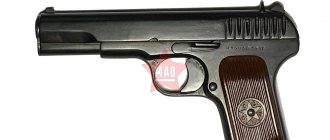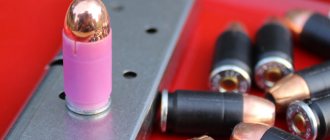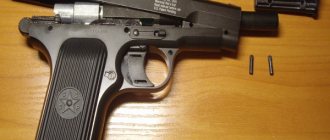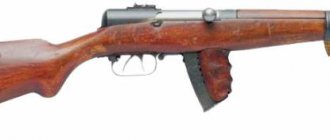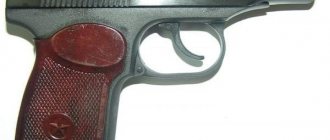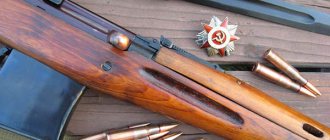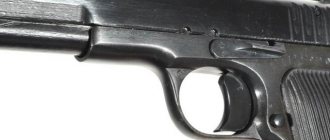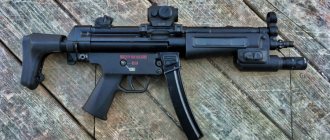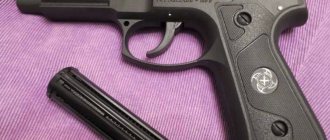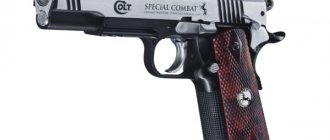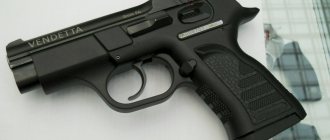TT combat pistol
The TT combat pistol did not appear by chance. It was developed for the 1929 competition for a new army pistol. It was assumed that the new development would replace the already obsolete “revolver”, as well as a number of pistols and revolvers in service with the Red Army. After testing domestic and foreign weapons, the choice was made on the TT pistol, which was developed by designer Fedor Vasilyevich Tokarev. Its combat characteristics were adequately appreciated not only in the USSR, but also in other countries. As a result, the TT pistol was adopted by 30 countries.
History of the development of the TT pistol
However, the commission headed by Grushetsky did not immediately accept the new pistol designed by Feder Tokarev for service with the Army. Some improvements were required to improve shooting accuracy, ease the trigger force and make it safer to handle. Taking into account all the requirements, Tokarev modified the weapon, and at the new competition on December 23, 1930, his pistol won. The new pistol received its name Tula-Tokarev thanks to its designer Fedor Tokarev and the design bureau of the Tula Arms Plant.
TT pistol 1929
In 1931, the first batch of 1000 new pistols was transferred to military units for testing. Having passed this stage, the Tulsky-Tokarev was adopted for service. It differed from its predecessors in its simplicity, manufacturability in production and operation. The 7.62 mm pistol cartridge “P” mod. was used as a cartridge for the combat TT. 1930. It was produced under German license.
Literally a year later, in 1932, the modernization of the combat TT began, according to new requirements. And in 1933, an updated model of the pistol was released: the barrel lugs were not milled, but were turned; the frame was made in one piece, without a removable handle cover; The disconnector and trigger rod were modified. At the beginning of 1934, the new pistol was put into service under the name “7.62-mm self-loading pistol mod. 1933."
TT pistol 1935
The year 1939 was marked by another modernization of the Tulsky-Tokarev pistol. A group of designers led by Tokarev created a version of the pistol with a more massive handle and a magazine for 12 rounds (for which its latch was moved). The likelihood of a spontaneous shot has been significantly reduced. The designers intended to further modernize the weapon, but these plans were interrupted by the Second World War, which is why the production of the pistol was moved to Izhevsk. It was here in 1942 that several batches of TTs with a two-row magazine for 15 rounds were manufactured. The thickness of the handle for this modification was 42 mm (versus 30.5 mm for the standard TT). The magazine latch was moved to the base of the handle. In 1944, a new update took place, and the pistol received a 16-round magazine, which was developed by designer Sevryugin.
TT pistol 1944 disassembled
Then economists came into play, demanding to reduce the cost of production of a combat TT, and in 1947, a newly modified pistol rolled off the assembly line: large vertical grooves, alternating with small grooves on the bolt casing for convenient retraction of the bolt, were replaced with small grooves (corrugation) .
It is worth noting that after the end of the war many copies of these weapons remained. The combat TT became held in high esteem by criminals, since its price on the black market was not high, and many barrels were not included in the bullet case of the Ministry of Internal Affairs. This made it difficult to identify a weapon and trace the history of its use.
TT pistol 1951
Since the beginning of the 90s, the TT pistol became a weapon for killers - it was cheap, it was almost impossible to trace its chain of movement, its combat characteristics were superior to all existing analogues, and a homemade silencer for it was quite simple to make. Therefore, killers often threw away their weapons without regret right there at the crime scene, having previously erased their fingerprints.
Military career
The defeat of the summer of 1941 led to the fact that the Red Army simply began to run out of weapons. In addition, evacuations, shortages of skilled workers and increased plans to replace huge losses in weapons led to a sharp drop in quality. If the pre-war TT began to “glitch” after 1000 shots, then military-issue pistols could withstand at most 700-800 shots without breakdowns or delays. Particularly unsuccessful were the pistols produced in 1942, which were distinguished by emphatically rough metal processing and simplified wooden grips instead of ebonite ones. However, wooden overlays were often found on TTs produced in 1943-45.
The situation was also aggravated by the use of armor-piercing cartridges from submachine guns. This led to rapid wear of the TT, which was already not “suffering” from a long service life. At the same time, there were cases of breakage of the firing pin stoppers, after which the latter flew into the shooter’s face, and other malfunctions (for example, swelling of the chamber, after which the cartridge case could only be removed with the help of a rod and a hammer). However, this was not so scary, since the main weapon of officers since 1942 has become a machine gun, and the pistol gradually turned into a “last chance” weapon.
Interestingly, captured pre-war TTs were used in the Finnish and even German armies. In the Wehrmacht, the TT under the designation Pistole 615 (r) was issued to rear and security units, police (in occupied territories), as well as volunteers (for example, Kuban Cossacks) who fought on the side of the Third Reich.
TT pistol design
During the Great Patriotic War, the TT pistol was the main personal weapon of officers and generals of the Soviet Army and was intended for close combat at distances of up to fifty meters.
The pistol is a self-loading short-barreled weapon in which the feeding and chambering of a cartridge into the chamber, locking and unlocking of the barrel, removal from the chamber and ejection of the spent cartridge case are carried out automatically. The automatic operation is based on the well-known Browning principle, in which the inertial recoil mass is formed by a bolt engaged with the barrel during a short stroke. The pistol is fired in single shots. The cartridges are fed from a flat box magazine located in the pistol grip. Among domestic and foreign pistols, the TT is distinguished by its high penetration ability and destructive power. These qualities are ensured by a powerful cartridge and a fairly long barrel length.
TT pistol design
In the initial position, the loaded magazine is inserted into the pistol handle, the trigger is on the safety cock. To fire the first shot, the hammer is cocked, the bolt is retracted to the rearmost position and abruptly released. Under the action of the return spring, the bolt moves forward, captures and advances the cartridge into the chamber, engages with the barrel and locks the barrel in the forward extreme position. The pistol is ready for the first shot.
When you press the trigger, the trigger rod presses on the protrusion of the sear and turns it, causing disengagement from the trigger, which, under the action of the mainspring, turns and hits the firing pin - a shot occurs. The resulting powder gases, acting on the bottom of the cartridge case, cause the bolt to roll back. The barrel, held by the protrusions in the grooves, moves along with the bolt, gradually lowering down under the action of the earring. By the time the pressure of the powder gases drops to a safe value, the movable coupled “bolt” system will have passed about three millimeters, and the barrel will disengage with the bolt. Having walked a little further forward and dropped down, he hits the frame of the pistol and stops. The bolt, together with the sleeve held by the ejector in the front cup, continues to move backward. When it encounters a reflector, the sleeve is ejected. The hammer is cocked and goes behind the combat cock.
Combat TT disassembled
At the same time, the shutter, with its bevel, recesses the disconnector, thereby disengaging the sear and the trigger rod. The sear, turning freely, goes behind the combat cock and holds the hammer in the cocked position. The next shot is possible only after pressing the trigger again. The shot will occur only after the barrel is completely locked, when the disconnector can rise into the corresponding recess of the bolt and allow the trigger rod to move in front of the sear.
Design features of the 7.62 mm pistol of the 1930 model
For his brainchild, Tokarev used the most successful developments of his predecessors: the creator combined in his pistol some features of several systems developed before him. We are talking about the Colt M1911 and its bore locking device, the Browning M1903 design, the Mauser C96 cartridge. He introduced his own design solutions: he placed the trigger device in a separate block.
It could be removed from the frame to clean and lubricate the weapon. Tokarev placed the mainspring in the trigger and made further modifications to make the weapon convenient to use. The automation is made according to a scheme with a short stroke of the weapon barrel.
The TT pistol is an automatic short-barreled weapon. The body is flat, length – 195 mm, height – 133 mm, width – 28 mm, barrel length – 116 mm. Thanks to its compact size, the TT is comfortable to wear. The ammunition is automatically fed and sent into the chamber, the barrel bore is locked and unlocked automatically, and the used cartridge case is ejected.
Shooting is carried out in single shots. The clip is placed in the handle.
Thanks to its powerful cartridge and long barrel, the TT pistol was considered one of the best examples of that time in terms of its penetration capabilities and destructive power.
The main parts and devices of the TT pistol disassembled:
- The frame connects the parts of the weapon and is the base and block of the trigger mechanism. The cheeks are attached to the handle. The automatic pistol clip latch is located between the handle and the trigger. It is designed to limit the movement of the release hook. At the top of the frame there is a moving part: a barrel with an earring, a bolt with a return spring.
- The barrel is cylindrical with a tide. Inside it is a chamber and a channel with 4 riflings, which impart a rotational movement to the bullet. Half-rings-grooves are cut out on the outside (for connection with the casing), a boss with a groove and a bevel for the earring is attached to facilitate feeding the cartridge from the magazine into the chamber.
- The bolt casing is a part of a self-loading pistol, located on top of the barrel. Here the shutter is a single unit with the casing. The barrel moves inside it and other parts of the impact device and a return spring are placed. There is a bushing attached to the front. The muzzle of the barrel is placed in its upper hole. The shutter moves along protrusions on the frame. When the bolt moves backward, the hammer is cocked, and when the bolt moves back, the cartridge is fed into the chamber.
- The trigger mechanism is a separate unit, so assembling and disassembling the TT pistol does not require much effort. The device consists of a trigger, hammer and sear with springs, an axis and a disconnector. The trigger is needed to strike the firing pin. The sear keeps the trigger cocked. The mainspring powers it. The firing pin is a solid metal cylinder with a thin leading edge, the so-called needle. The disconnector is also needed to protect against shots. The trigger is designed for single shots. Rate of fire – 30 rounds per minute.
By pressing the trigger, the trigger and mainsprings are activated, and the sear is deactivated (it disengages from the trigger). Now the hammer is out of the cocked state, the mainspring presses on it and the hammer hits the firing pin.
He immediately pierces the Boxer's primer and the gunpowder ignites and detonates.
- The sighting devices of the device are front and rear sights. The TT is zeroed at 25 m.
- The clip is a box for 8 cartridges, equipped with a spring and a feeder. It is placed in the handle and fixed.
- The bolt stop is a solid metal part, a plate with a rod and a tooth. As soon as the magazine runs out of cartridges, the bolt rises up and holds the bolt housing in the rear position. Thus, the shooter receives a signal that the time has come to reload the magazine. The device also serves to minimize the number of idle strikes on the firing pin.
For maintenance (cleaning, lubrication), the weapon must be disassembled (not completely). For example, if the weapon is heavily contaminated, exposed to rain or snow, before repair, or when switching to another lubricant.
Then assemble and inspect whether it is assembled correctly and how the mechanisms work. Often you should not completely disassemble the TT pistol; this will lead to its parts wearing out faster.
Advantages and disadvantages of combat TT
The TT pistol is distinguished by its simplicity of design and, therefore, low production costs and ease of maintenance. A very powerful cartridge, atypical for pistols, provides unusually high penetrating power and muzzle energy of about 500 J. The pistol has a short, light trigger and provides significant shooting accuracy; an experienced shooter is able to hit a target at distances of more than 50 meters. The pistol is flat and quite compact, which is convenient for concealed carry. However, during operation, shortcomings also appeared.
Before the Great Patriotic War, the military put forward a requirement that a pistol could be fired through the embrasures of a tank. The combat TT did not satisfy this condition. Many experts consider this requirement absurd. Another drawback is poor magazine retention. There were cases of involuntary shooting. Ultimately, the Charter specifically prohibited carrying a pistol with a cartridge in the chamber.
Tulsky-Tokarev
The ergonomics of the TT raises many complaints compared to other designs. The angle of inclination of the handle is small, its shape is not conducive to comfortable holding of the weapon.
The TT pistol is distinguished by its flat trajectory and high penetrating effect of a pointed bullet, which is capable of piercing an army helmet or light body armor. The penetrating effect of a TT bullet exceeds the penetrating effect of a bullet from a 9x19 mm Parabellum cartridge (after being fired from a TT pistol, a “7.62 P” bullet with a lead core penetrates body armor of class I protection, but does not penetrate class II body armor even when shot at point-blank range.
Video about the TT pistol
The Pst bullet with a steel core penetrates body armor of protection class II, or NIJ IIIA+ according to the American classification). At the same time, the stopping effect of 7.62 mm TT bullets is inferior to that of a 9x19 mm cartridge bullet. However, in the TT pistol it is possible to use several variants of 7.63×25 mm Mauser cartridges with bullets of increased stopping power:
- .30 Mauser LLC - cartridge with a non-jacketed lead bullet (USA);
- cartridge with an expansive bullet (USA);
- 7.62x25 mm Tokarev Magsafe Defender - a cartridge with a bullet of increased stopping power (USA).
Characteristics of the TT combat pistol:
- Weight, kg: 0.854 (without ammunition) 0.94 (loaded)
- Length, mm: 195
- Barrel length, mm: 116
- Height, mm: 130
- Cartridge: 7.62x25 mm TT
- Caliber, mm: 7.62
- Operating principles: recoil with a short barrel stroke, bolt misalignment
- Initial bullet speed, m/s: 420—450
- Sighting range, m: 50
- Maximum range, m: 1650
- Type of ammunition: magazine for 8 rounds
- Sight: open, non-adjustable
Necessary materials
To do this, you will need some tools and materials that can easily be found at home or in the country: a board made of non-solid wood, a ruler, a pencil or pen, a plane, a hacksaw, a file, a vice or clamps, a wood burning machine, sandpaper and varnish. This will be quite enough to make a homemade pistol made of wood.
Some stages in the process of making a toy can be done by a child. Direct participation in the process of making a pistol will not allow him to get bored.
Another important and desirable point in making homemade weapons is a drawing of a pistol made of wood. You can easily find it on the Internet or draw it yourself, taking into account all the wishes for the future product.
TT options and modifications
Based on the TT pistol, many modifications of the pistol were created by Soviet and foreign designers for various purposes. Based on the drawings transferred by the USSR to Hungary, a modified scheme was developed: the weapon was intended for 9 mm cartridges. In China, according to Soviet drawings, the TT pistol was produced, first with the index “type-51”, later - “type-54”.
Sports weapons
At the very end of the Second World War, the process of conversion of military production began. The designers were tasked with developing a small-caliber sports pistol. First the R-3 was developed, then the R-4 for the small-caliber 5.6 mm cartridge. The S-TT sports pistol was produced in the 30s–50s; it is no different from the combat prototype.
Traumatic weapon
Trauma is a weapon for self-defense.
- TT-Leader. Its prototype is the TT-33. The version retains the design and construction of the trigger. Accuracy leaves much to be desired. Instead of a barrel there is a simulator (there is no barrel), as a result the spread of bullets is too large even for a traumatic weapon. Out of production. TT-T is another version based on military weapons.
- MP-81 - based on the TT: the frame, bolt, and trigger were copied (combat pistols were remade). Used with rubber bullets and traumatic cartridges, gas and noise cartridges.
Pneumatic versions
The pistols listed below are 4.5mm caliber:
- Gletcher TT. It has a plastic body, so it is quite lightweight - up to 400 g. The shutter is stationary. It is reputed to be a reliable model and is easy to maintain. Good aiming.
- Gletcher TT NBB is a gas-cylinder smoothbore multi-charger. The design is similar to the self-loading TT.
- TTP "Sobr" - gas-cylinder pneumatics produced in Ukraine. The pistol has been discontinued.
- Crosman C-TT is a multi-shot model.
Signal versions
The TT-S signal pistol is a modification of the VPO-501 “Leader”, based on the Tokarev pistol. Production has been discontinued, since modern law prohibits the alteration of military weapons.
Collectibles
Among the collectible weapons there are combat weapons with marks and training ones. It is legally possible to purchase copies that cannot be fired with live ammunition. By May 9, 2022, the famous jewelry brand released collectible TT pistols - modified versions decorated with gold.
TT pistol 1951 in gift version
It is worth adding about the Tokarev pistol that the TT is officially considered a premium pistol along with the Makarov pistol, Nagan system revolver, etc.
